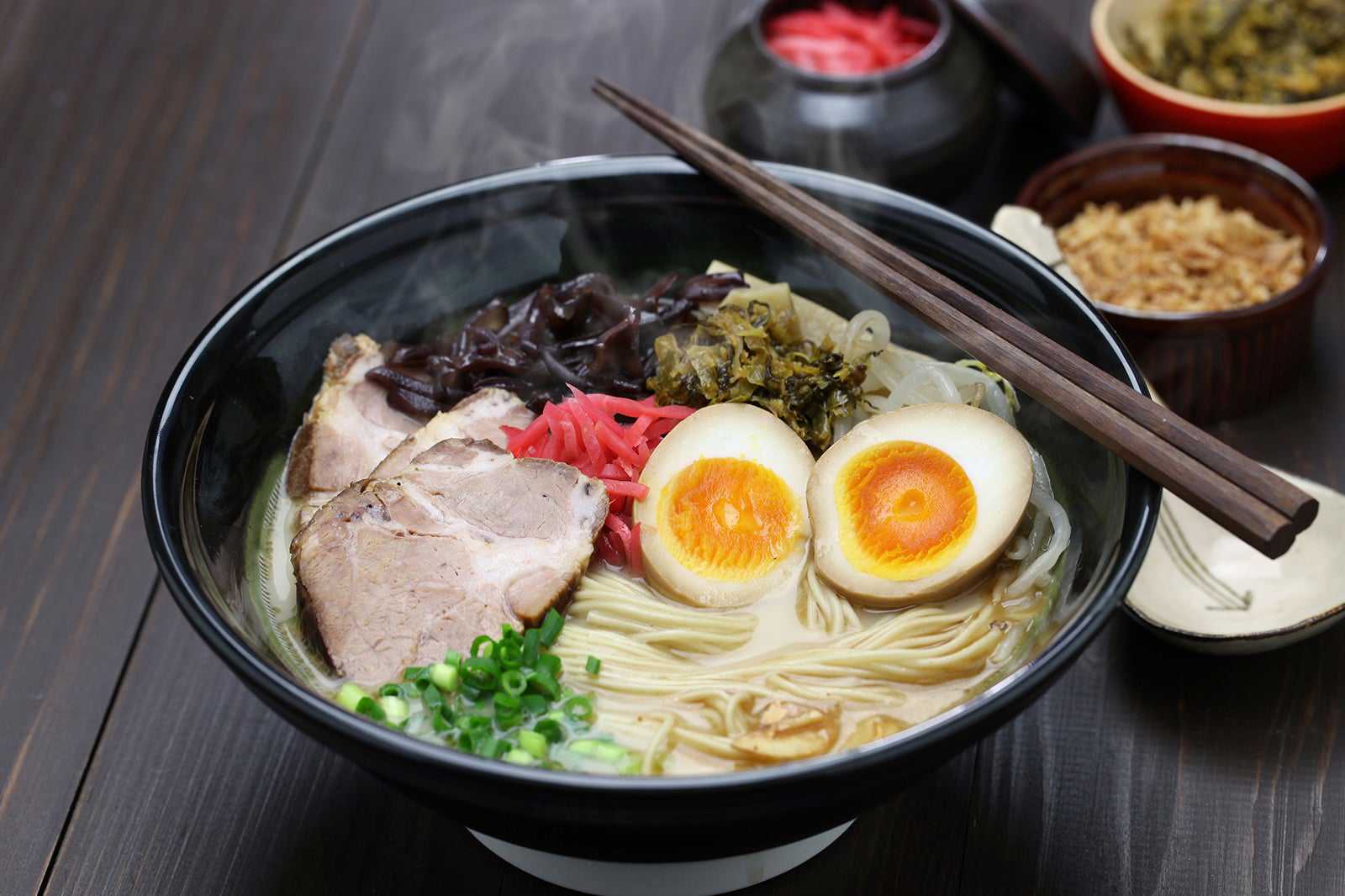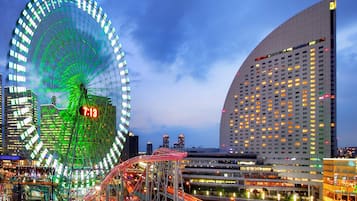The best local dishes from Yokohama are among the best of Chinese specialities. If you’d like to enjoy a light meal early in the morning, try chuka gayu (Chinese rice porridge). Or sample some of the irresistible shoronpo (soup dumplings) and chashu (barbecued pork). Other famous delicacies that you can also take back as souvenirs are geppei (mooncakes).
The local cuisine of the Kanagawa Prefecture is heavy on the veggies, especially in dishes such as kenchin-jiru (tofu and vegetable chowder) and gyunabe (beef hotpot). Also, don’t miss Yokohama’s delicious cheap eats like sanmamen (ramen with bean sprouts) and iekei ramen (soy sauce-based pork ramen). Savour your exploration of the best local cuisines in Yokohama.
- 1
Gyunabe (Beef hotpot)
Simmered beef delicacy

- Pároknak
- Családoknak
- Ételek
Gyunabe (beef hotpot) originated in Yokohama after the foreign culture of eating beef began to spread throughout Japan in the early Meiji period. In an iron hotpot, beef, green onion, edible chrysanthemum, shiitake mushroom, shirataki konjac and tofu are stewed together with sukiyaki stock (a mixture of soy sauce, mirin, sugar, sake and stock).
Gyunabe looks just like sukiyaki. The difference between the 2 is that the meat is grilled in sukiyaki but simmered in gyunabe. Try the gyunabe in the famous old restaurants in the Naka Ward of Yokohama City, many of which were established in the Meiji era.
A kép készítője: Danglewis (CC BY-SA 3.0) módosítva
- 2
Iekei ramen (House-style ramen)
Thick noodles in creamy soup

- Olcsó
- Ételek
Iekei ramen consists of chewy, straight, thick noodles in a creamy soup made with pork bone and soy sauce. The dish is usually topped with roasted pork fillet, spinach and seaweed. Mr Yoshimura came up with the idea of mixing pork bone broth from Kyushu with soy sauce from Tokyo, which resulted in him establishing Yoshimura-Ya Restaurant in Yokohama.
Ramen shops that established business with his help also named their shops with '-Ya' ('ya' means 'house' or 'family'). As a result, this type of ramen is called house-style ramen. You can customise the thickness of the taste, the amount of fat and the temperature of your noodles at just about every iekei ramen shop in Yokohama City.
A kép készítője: Tatsuo Yamashita (CC BY 2.0) módosítva
- 3
Edomae sushi
Sushi made in Kanto for hundreds of years

- Ételek
- Történelmi környezet
Edomae sushi is how people in the Kanto region have consumed sushi for hundreds of years. Edomae refers to seafood caught from Tokyo Bay; local anglers would catch eels, tiger prawns, tuna and more. However, with refrigeration scarce in the 1800s, sushi chefs would preserve raw fish in salt, vinegar, soy sauce and other curing products.
This way of curing seafood continues to be used by sushi chefs in Yokohama and around the globe. Head to a top-notch sushi spot to experience this traditional technique and understand why some chefs prefer this method for bringing out certain seafood flavours.
- 4
Kenchin-jiru (Tofu and vegetable chowder)
Traditional tofu dish

- Pároknak
- Családoknak
- Ételek
Kenchin-jiru is a popular local dish that originated from Kencho-Ji temple in Kamakura some 700 years ago. Its origin is said to be a soup made by simmering tofu with vegetables to avoid wasting crumbled tofu.
First, you cut root vegetables like carrots, radishes, taro, seasonal vegetables and konjac into chunks and stir-fry them with sesame oil. Add the broth of kombu (kelp) and shiitake mushrooms and the crushed tofu, simmer, season with soy sauce and top with chopped green onions. This is a great dish to enjoy as either a set meal or a rice bowl dish at restaurants across the Kanagawa Prefecture.
A kép készítője: Kentin (CC BY-SA 3.0) módosítva
- 5
Xiaolongbao (Soup dumplings)
Beautiful and delicate dumplings

- Pároknak
- Családoknak
- Ételek
Xiaolongbao (soup dumplings) are one of the most popular Chinese snacks. This delicacy is made with ground pork wrapped in thin flour dough and steamed in a basket steamer (seiro). For maximum freshness, we recommend restaurants that steam the soup dumplings only after you place your order.
If you put a steamed soup dumpling on a spoon and break it with your chopsticks, you’ll find hot soup oozing out from the inside. Freshly steamed dumplings are best eaten while still hot. While delicious on their own, soup dumplings also go really well with black vinegar and ginger. In Yokohama’s Chinatown, you can also enjoy grilled soup dumplings and unique dishes with shrimp and shark fin.
- 6
Sanmamen
Yokohama's soul food

- Olcsó
- Ételek
Sanmamen is said to have come from the staff meals served at Chinese restaurants. Sanma (mackerel pike) could bring to mind the fish of the same name, but the kanji characters used in sanmamen are completely different. The Chinese characters translate to 'fresh and crisp texture' and 'put on top' which explains the concept of the dish.
Pork, Chinese cabbage, cloud ear mushrooms, carrots, bamboo shoots, Chinese chives and a lot of bean sprouts are stir-fried quickly, thickened and poured on top of noodles. The original sanmamen was made with soy sauce-flavoured soup, but some restaurants serve salty versions. You can find sanmamen at ramen shops and Chinese restaurants throughout Yokohama City.
- 7
Shumai (Steamed Chinese dumplings)
Dumplings with a Yokohama twist

- Olcsó
- Ételek
Kiyoken's shumai is a Yokohama speciality that has been loved by the citizens of Yokohama since it was introduced in 1928. Based on the hot, steamed dumplings served in Chinatown, this take on shumai results in a dumpling that’s still tasty even after it has cooled down.
Shumai traditionally contains a mixture of pork and dried scallops, but there are also shrimp and crab variations that originated from the Heisei era. It’s also bite-sized, which means it’s easy to enjoy on the go. Kiyoken first sold shumai bento (boxed lunches) at train stations in Yokohama in 1954. It has become so popular that it sells about 20,000 boxes a day. Make sure you grab one when sightseeing in Yokohama.
A kép készítője: Miya.m (CC BY-SA 3.0) módosítva
- 8
Geppei (Mooncake)
Tasty souvenirs

- Családoknak
- Ételek
Geppei (mooncake) is a Chinese confectionery made by mixing wheat flour with sugar, lard and hot water until it forms a dough. It’s then filled with red beans, lotus seeds, walnuts and Chinese dates hardened with syrup before being baked until golden.
In China, it’s tradition to eat mooncakes together with the family while watching the harvest moon. Locals believe the pastry’s circular shape represents family harmony. Originally, large cakes would be cut with a knife and eaten together. Nowadays, bite-sized geppei is available, usually sold as a souvenir in Yokohama’s Chinatown. Note that the mooncakes’ bean paste filling, size and crust pattern differ from store to store.
- 9
Chuka gayu (Chinese rice porridge)
Rich and nutritious porridge

- Pároknak
- Családoknak
- Ételek
Unlike Japanese rice porridge (okayu), which is made with only rice and water, chuka gayu (Chinese rice porridge) is cooked with chicken broth and meat or seafood. The cooking method varies slightly depending on the region, but the Cantonese version, which is prepared after frying it in oil, is particularly famous in Japan. Another feature is that it’s simmered for a long time until it thickens, giving it a lovely smooth texture.
Easily digestible and full of nutrition, Chinese porridge is a breakfast staple for many locals in Yokohama. Why not head for Chinatown first thing in the morning and enjoy the taste of Chinese rice porridge?
A kép készítője: hirotomo t (CC BY-SA 2.0) módosítva
- 10
Chashu (Roasted pork fillet)
Juicy and fragrant dish

- Pároknak
- Családoknak
- Ételek
Chashu (Roasted pork fillet) is made by marinating tender pork in a sauce overnight before slowly broiling it over charcoal. The chashu of Chinatown has a distinctive red colour because it’s prepared in dregs containing hóng zāo (red wine).
You’ll find some restaurants where the flavour of chashu has been adapted to suit Japanese tastes by limiting the use of spices, such as star anise. Ultimately, chashu is popular because it appeals to so many people. You can enjoy it in Chinese restaurants, buy it as a souvenir or relish it as a topping for fried rice, gyoza or ramen. Chashu buns are recommended for those on the go.


















